Kerry 1916: Histories and Legacies of the Easter Rising: A Centenary Record
edited by Bridget McAuliffe, Mary McAuliffe, Owen O’Shea
(Irish Historical Publications, €25 pb / €35 hb)
This excellent book is a worthy act of homage to the Kerry men and women who were involved in the Easter Rising. Across the 320 pages there are extensive profiles of the principals such as Thomas Ashe, the O’Rahilly and Austin Stack.
Also included are descriptions of the actions of Sir Roger Casement and Karl Spindler, captain of the Aud. In addition there are biographical sketches of over a hundred men and women who were arrested and imprisoned after the Rising because of their membership of the Irish Volunteers or Cumann na mBan.
When visiting Tralee on February 27, 1916 Patrick Pearse informed Austin Stack that plans had been prepared by the IRB’s Military Council for an insurrection, that arms were to be landed at Fenit pier on Easter Sunday/Monday, that the Tralee Volunteers were to be responsible for this operation, and that the landed arms were to be used firstly to arm the Kerry Volunteers and then to be distributed to the Cork, Limerick, Clare and Galway Volunteers.
Occasion
On the same occasion Pearse appointed Stack over the Volunteers in Kerry and emphasised that no action should be taken by them which could alert the authorities before the Rising had begun in Dublin.
Stack was meticulous and most secretive in making preparations for the landing and distribution of the arms from Germany. However, the Aud with its consignment arrived three days before schedule and there was no pilot to guide it into Fenit.
A day later a submarine with Roger Casement and Julian Bailey and Captain Robert Monteith of the Irish Brigade, recruited in Germany, arrived and failed to rendezvous with the Aud. Worse still, Casement and his companions came ashore at Banna Strand and Casement was arrested and detained in the RIC barracks in Tralee.
Considering the operation at Fenit was a lost cause and mindful of the stiff injunction that there was to be no incident in Kerry which would alert the authorities before the Rising had begun in Dublin, Stack had himself arrested. His decision ever since has subsequently occasioned much controversy. However, it should be noted that in a subsequent inquiry the Irish Volunteer leadership found no fault with him for his actions during Holy Week 1916.
Apart from the shambles in Tralee Bay and the confusion caused by Eoin MacNeill’s countermand, the Kerry Volunteers faced formidable challenges. Ranged against them were an unsympathetic population, some 200 British troops in Ballymullan barracks, about 270 members of the paramilitary RIC and a small number of marines on the coastline. Without the rifles, machine guns and ammunition from the Aud they were inadequately armed.
Paddy Cahill later revealed they were seriously short of munitions: “At most we could only last a half-an-hour…” In the event, the only shots fired in Kerry during Easter Week were the result of an accidental confrontation on Easter Saturday. This occurred at Firies, where James Riordan of the local company wounded two members of the RIC, one fatally.
There were Kerry links with the fighting in Dublin. Michael Mulvihill, Patrick O’Connor and Patrick Shortis had all been employed in London, where Mulvihill and Shortis joined the Volunteers, with O’Connor joining later.
All three were killed along with The O’Rahilly in an unsuccessful attempt to break out of the blazing GPO. Thomas Ashe survived a successful military action in Ashbourne, but he too not long afterwards was ‘to die for Ireland’.
The Easter Rising prompted the War of Independence and much else, and is regarded as the birth of the nation. This splendid publication illustrates the significant role played by Kerry men and women in that seminal event.


 Volunteers gathered in Dingle c.1915.
Volunteers gathered in Dingle c.1915. 